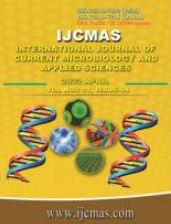


 National Academy of Agricultural Sciences (NAAS)
National Academy of Agricultural Sciences (NAAS)

|
PRINT ISSN : 2319-7692
Online ISSN : 2319-7706 Issues : 12 per year Publisher : Excellent Publishers Email : editorijcmas@gmail.com / submit@ijcmas.com Editor-in-chief: Dr.M.Prakash Index Copernicus ICV 2018: 95.39 NAAS RATING 2020: 5.38 |
The global incidence of carbapenem resistant organisms is on the rise and can be attributed to indiscriminate use of carbapenem to tackle the Extended Spectrum Beta Lactamase (ESBL) producing organisms. Carbapenem resistance is associated with resistance to other group of antibiotics. The spread of resistance from one bug to another is not uncommon. The organism persists in the hospital environment and is identified as cause of hospital-acquired infections. This is not only a major concern in the healthcare setting but is also increasingly being recovered from community settings also. Limited availability of drugs to treat these infections is the biggest concern. Identifying carbapenem resistant organisms and implementing measures to prevent the spread is need of the hour. The aim of this study is to determine the prevalence and susceptibility pattern of Carbapenem resistant Enterobacteriaceae. Materials and Methods: A descriptive study was carried out in the central laboratory of Microbiology, tertiary care teaching institute of Narayana medical college and Hospital, Nellore, AP, India. All Enterobacteriaceae isolates recovered during the six months study period of August 2021 to January2022 were included in the study. The isolates were identified using vitek2. Antimicrobial susceptibility was performed using vitek2. Results: A total of 592 isolates of Enterobacteriaceae were recovered during the study period. The different samples included sputum158, urine 242, blood 56, pus 136. Out of which592 isolates, 126 are resistance (21.28%). The strains isolated includes Escherichia coli, klebsiella pneumonia and other speces (Proteus spp.,, Citrobacter sp, serracia). Escherichia coli (246), Klebsiella pneumoniae (177), other speces 169 (Proteus sp, Citrobacter sp, serratia). Escherichia coli strains 72(29.26%), klebsiella pneumonia strains 30(16.95%) others strains (Proteus spp., Citrobacter sp, serratia) 24(14.20%) are carbapenem resistant enterobacteriaceae (CRE). Conclusion: The prevalence of Carbapenem resistant isolates is high in our settings. Strict adherence to infection control practices and stringent implementation of antimicrobial stewardship is essential to curb the rate of Carbapenem resistant isolates.
 |
 |
 |
 |
 |